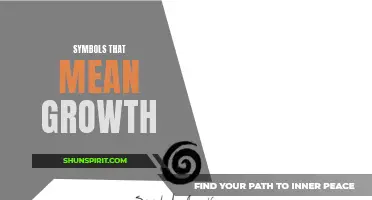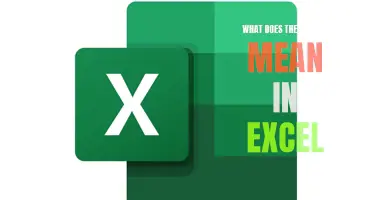
Have you ever noticed a small lock symbol next to a website's URL? If you have, you may be wondering what it means and why it's important. Well, that lock symbol is a vital indicator of website security and can give you peace of mind when browsing the internet. In this article, we will dive into what this lock symbol means and why it should never be ignored.
What You'll Learn
- What does the lock symbol mean when it appears on a website or browser?
- How does the presence of the lock symbol indicate that data shared on a website is secure?
- Are there different types or variations of the lock symbol, and do they have different meanings?
- Can the lock symbol guarantee complete security of personal information when browsing or using online services?
- What steps should users take if they do not see the lock symbol on a website that requires them to enter sensitive information?

What does the lock symbol mean when it appears on a website or browser?
When browsing the internet, you may have noticed a small lock symbol that appears next to the website's address in your browser's address bar. This lock symbol is an important indicator of the website's security.
The lock symbol signifies that the website you are visiting is using a secure connection, also known as Secure Sockets Layer (SSL) or Transport Layer Security (TLS). This means that any information you provide on the website, such as your login credentials or credit card details, is encrypted and protected from unauthorized access.
Encryption is the process of converting data into a code that cannot be easily read by anyone who does not have the encryption key. When you visit a website with a lock symbol, your browser and the website establish a secure connection and exchange encryption keys. This ensures that the information you send and receive on the website is only accessible to you and the website's server.
Why is this important? Well, without a secure connection, your personal information could be intercepted by cybercriminals who could use it for malicious purposes such as identity theft or financial fraud. By using encryption, the lock symbol provides peace of mind that your data is being transmitted securely.
In addition to the lock symbol, you may also notice that the website's address starts with "https://" instead of just "http://". The "s" at the end stands for "secure" and indicates that the website is using SSL/TLS encryption.
It is essential to always look for the lock symbol and "https://" when entering sensitive information on a website. This is especially important when making online purchases, logging into your online banking account, or providing personal information on forms.
However, it's worth noting that the lock symbol alone does not guarantee the trustworthiness of a website. While it indicates that your connection to the website is secure, it does not necessarily mean that the website itself is safe or legitimate. It's important to exercise caution and follow other security best practices, such as verifying the website's legitimacy and using strong, unique passwords.
In conclusion, the lock symbol that appears on a website or browser signifies that the website is using a secure connection with SSL/TLS encryption. This ensures that any information you provide on the website is protected from unauthorized access. Always look for the lock symbol and "https://" when entering sensitive information online to ensure your data is transmitted securely.
Exploring the Symbolic Meaning of Bronze in the Bible
You may want to see also

How does the presence of the lock symbol indicate that data shared on a website is secure?
When browsing the internet, it is essential to ensure that your sensitive information is protected. Many websites use encryption technology to secure the data you share with them. One common way to indicate that a website is secure is through the presence of a lock symbol in the browser's address bar or in the website's user interface.
The lock symbol indicates that the website has an SSL (Secure Sockets Layer) certificate installed. This certificate is issued by a trusted certificate authority and acts as a digital passport that verifies the identity of the website and provides a secure connection for transmitting data.
When you access a website with SSL, your browser and the website's server establish an encrypted connection. This encryption process ensures that any information you send, such as login credentials, credit card numbers, or personal information, is securely transmitted and protected from eavesdropping or unauthorized access.
The lock symbol is a visual representation that the SSL certificate is valid and the website's identity has been verified. By clicking on the lock symbol, you can view detailed information about the website's certificate, including the issuer and its validity.
The presence of the lock symbol alone does not guarantee the overall security of a website. It only indicates the secure transmission of data between your browser and the website. However, it is an important indicator that the website takes security seriously and has taken steps to protect your information.
It is important to note that not all websites are required to have SSL certificates. Websites that handle sensitive information, such as online banking, e-commerce platforms, or websites that collect personal information, are more likely to have SSL certificates. However, the absence of a lock symbol does not necessarily mean that a website is insecure or malicious.
To ensure the security of your data, it is recommended to look for the lock symbol when providing sensitive information on a website. Additionally, you can verify the SSL certificate by checking the website's URL. Secure websites typically begin with "https://" instead of "http://". The "s" in "https://" stands for secure, indicating that the website has an SSL certificate.
In conclusion, the presence of a lock symbol on a website indicates that the data shared on the website is secure. It signifies that the website has an SSL certificate installed and encrypts the data transmitted between your browser and the website's server. While the lock symbol is a good indicator, it is important to remain vigilant and ensure that you are providing sensitive information on trusted and secure websites.
Understanding the Snowflake Symbol on Your Thermostat
You may want to see also

Are there different types or variations of the lock symbol, and do they have different meanings?
The lock symbol is a common icon seen on websites, browsers, and devices to indicate that a connection is secure or that information is encrypted. It is a symbol that people often associate with online security and protecting sensitive data. However, there are different types or variations of the lock symbol, and they can have different meanings depending on their design and context.
One common variation of the lock symbol is the open lock. This symbol typically appears when a connection is not secured or when there may be potential risks associated with sharing or transmitting information. It serves as a warning to users that they should exercise caution when entering sensitive information or conducting transactions.
On the other hand, the closed lock symbol is often used to represent a secure and encrypted connection. It indicates that the website or device has implemented measures to protect data from unauthorized access or interception. This symbol provides reassurance to users that their information is safe and that they can proceed with confidence.
In addition to the open and closed lock symbols, there are also variations that incorporate additional elements. For example, some lock symbols may feature a shield surrounding the lock, symbolizing an extra layer of protection. This can indicate that the website or device has implemented advanced security measures, such as firewall protection or intrusion detection systems.
Another variation is the padlock symbol, which is often used to represent secure login forms or password-protected areas. The padlock symbolizes that the user's credentials and personal information are being securely transmitted and stored.
It's important to note that the meanings of the lock symbols can vary depending on the context in which they are used. For example, a lock symbol on a website's login page may indicate secure transmission of data, but it does not necessarily guarantee the overall security of the website. Similarly, a lock symbol on a browser's address bar may indicate a secure connection to a website, but it does not guarantee the legitimacy or trustworthiness of the site.
In summary, there are different types and variations of the lock symbol, each with its own meaning. The open lock symbol typically represents a lack of security or potential risks, while the closed lock symbol indicates a secure and encrypted connection. Additional elements such as shields or padlocks may imply extra layers of protection. However, it is important to consider the context in which the lock symbol is used and not solely rely on it as an indicator of overall security.
Demystifying the Airbag Symbol: What Does it Mean and Why is it Important?
You may want to see also

Can the lock symbol guarantee complete security of personal information when browsing or using online services?
In today's digital age, personal information has become more vulnerable than ever. With the rapid advancement of technology, the need for secure browsing and online services is of utmost importance. One symbol that is often associated with online security is the lock symbol, which is commonly seen on websites and browsers. But can this lock symbol truly guarantee complete security of personal information?
The lock symbol represents that a website has a secure connection using SSL (Secure Sockets Layer) encryption. This encryption ensures that all data transmitted between the website and the user remains private and cannot be intercepted by any third party. When a website has a valid SSL certificate, it is indicated by the presence of the lock symbol in the browser's address bar or a padlock icon in the bottom right corner.
While the presence of the lock symbol indicates that the communication between the user's browser and the website is secure, it does not guarantee the overall security of the website or the protection of personal information. The lock symbol only ensures the encryption of data during transmission, but it does not guarantee the security of the website's server or database where the personal information is stored.
To ensure the complete security of personal information when browsing or using online services, it is important to consider other factors beyond the presence of the lock symbol. Here are a few additional steps that users can take to enhance their online security:
- Keep your software up to date: Regularly update your operating system, web browsers, and other software to ensure that you have the latest security patches and features.
- Use strong, unique passwords: Avoid using the same password for multiple accounts and create unique, complex passwords that are difficult to guess.
- Enable two-factor authentication: Many online services offer two-factor authentication, which adds an extra layer of security by requiring you to verify your identity through a second factor such as a code sent to your mobile device.
- Be cautious of phishing attacks: Phishing attacks often trick users into revealing their personal information by impersonating a legitimate website or service. Be wary of suspicious emails, messages, or pop-ups and avoid clicking on unknown links.
- Use a reputable antivirus program: Install a reliable antivirus program on your device to help detect and prevent malware and other threats.
While the lock symbol is a good indication of a secure connection, it alone cannot guarantee the complete security of personal information. It is essential for users to understand the importance of taking additional measures and being proactive in protecting their personal information when browsing or using online services. By following best practices and staying informed about the latest security threats, individuals can better safeguard their personal information in the digital world.
Understanding the Symbolism and Meaning Behind Passover: A Deep Dive into the Ancient Traditions
You may want to see also

What steps should users take if they do not see the lock symbol on a website that requires them to enter sensitive information?
When browsing the internet, it is important to ensure that the websites you visit are secure, especially when entering sensitive information such as credit card details or personal information. One way to determine if a website is secure is by looking for a lock symbol in the address bar of your browser. This lock symbol indicates that the website is using a secure HTTPS connection to encrypt your data and protect it from potential hackers.
However, there may be instances where you do not see the lock symbol on a website that requires you to enter sensitive information. This could be due to a few reasons, such as a technical issue or a problem with the website's security certificate. In such cases, it is important to take the following steps to ensure the safety of your information:
- Double-check the URL: Before entering any sensitive information, make sure that you are on the correct website. Check the URL in the address bar to ensure that it matches the website you intended to visit. Hackers may create spoofed websites that mimic popular ones, so it is important to be vigilant and verify the URL.
- Look for other security indicators: While the lock symbol is a good indicator of a secure website, there may be other security indicators to look out for. Some browsers may display a green address bar or a padlock symbol in the bottom-right corner of the window. If you see any of these indicators, it is likely that the website is secure, even if the lock symbol is not present.
- Contact the website owner: If you still have doubts about the website's security, it is a good idea to contact the website owner or customer service. They will be able to provide you with information about the website's security measures and address any concerns you may have.
- Use a secure payment method: If you are making a purchase online, consider using a secure payment method such as PayPal or a credit card with fraud protection. These payment methods offer an additional layer of security and can help mitigate the risk of your information being compromised.
- Install browser security extensions: To enhance your browsing security, consider installing browser extensions such as HTTPS Everywhere or Privacy Badger. These extensions can help enforce secure connections and protect your data while browsing the internet.
- Report suspicious websites: If you come across a website that you believe to be malicious or fraudulent, report it to the appropriate authorities. This can help prevent others from falling victim to online scams or phishing attempts.
It is important to prioritize your online safety and take necessary precautions when entering sensitive information on websites. While the absence of a lock symbol may raise concerns, following the steps mentioned above can help ensure that your information remains secure.
The Meaning Behind Saint Symbols: Decoding the Spiritual Messages
You may want to see also
Frequently asked questions
The lock symbol in your browser's address bar typically indicates that the website you are visiting is secure. It means that any information you enter on that website, such as passwords or credit card details, is encrypted and protected from unauthorized access.
To check if a website is secure, look for the lock symbol in the address bar of your browser. Additionally, the website's URL should start with "https://" instead of the standard "http://". The "s" in "https" stands for "secure" and indicates that the website uses encryption to protect your data.
While the lock symbol is generally a good indicator of a secure website, it does not guarantee complete safety. Some malicious websites may also have the lock symbol, so it is important to exercise caution and use other security measures, such as keeping your browser and antivirus software up to date, and avoiding suspicious websites.
If you do not see the lock symbol on a website that requires your personal information, it is recommended to proceed with caution. Consider contacting the website's customer support to inquire about their security measures. If you are unsure about the legitimacy of the website, it is best to refrain from entering any personal information.
Yes, websites with the lock symbol on your mobile device are generally trustworthy. Mobile browsers follow the same standards of displaying the lock symbol for secure websites. However, it is important to stay vigilant and be cautious when entering personal information on any device. Always ensure that you are accessing the website through a secure network and that your device is protected with updated security software.







